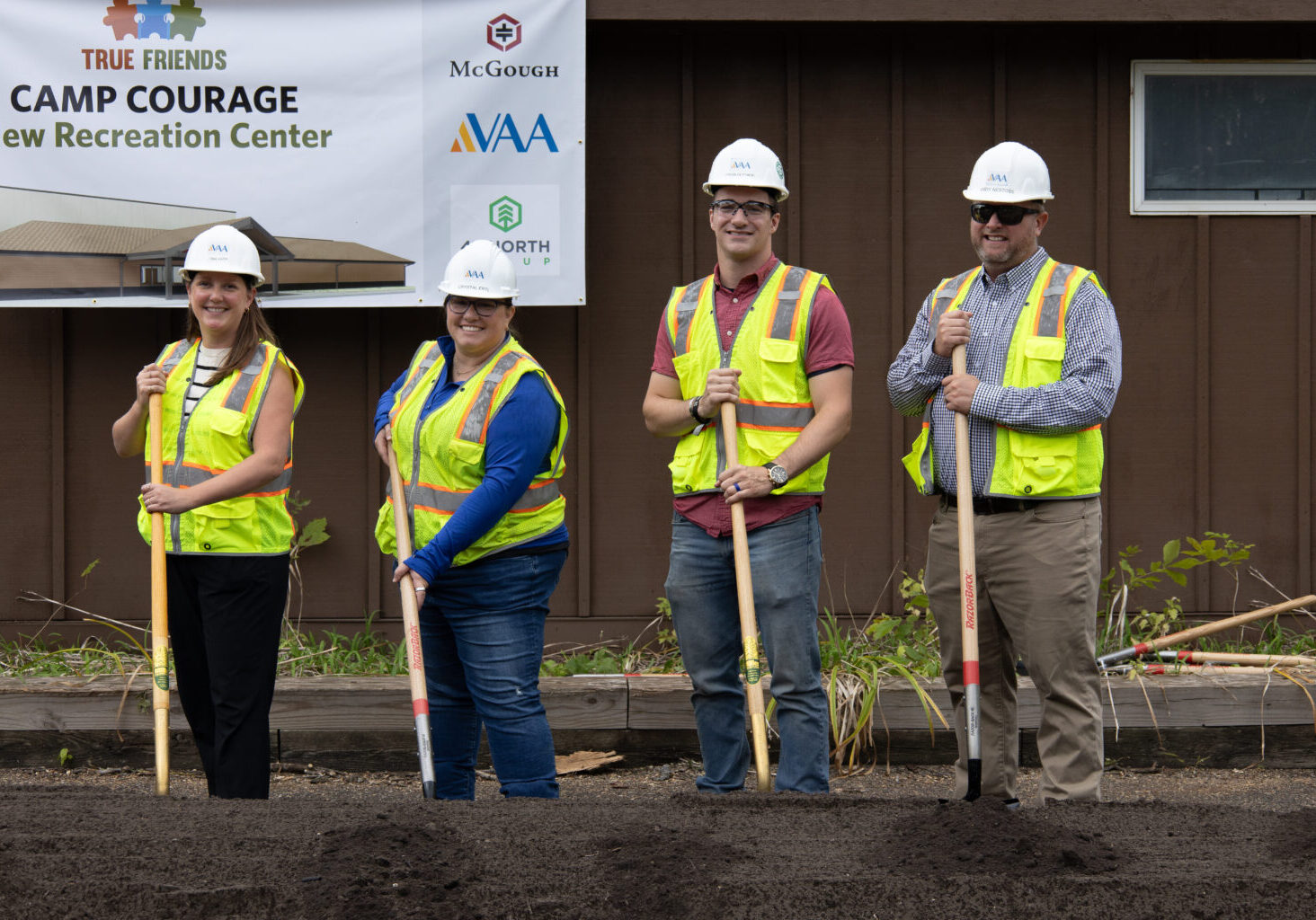VAA News | June 15, 2020
Protect Your Investments: Concrete Silo Safety and Operations
Safety and performance of concrete silos, particularly older silos, are often a concern to owners and operators of heavy industrial processing facilities. Blowout of silo walls and / or partial collapse of concrete silos are not uncommon. This article summarizes factors that contribute to concrete silo failure and defines methods to avoid instances that may compromise safety and operations at a facility.
IDENTIFYING POTENTIAL RISKS
Nature and Behavior of Stored Materials
In the agribusiness industry there are two broad categories of stored granular materials – free flowing bulk solids such as corn, wheat, soybeans and non-free flowing cohesive materials like DDGS, soybean meal and wheat middling. A fundamental question in the design of silos for storage of dry bulk solid materials is the determination of the pressures the material imposes on the silo structure. Methods for the determination of pressures in silo resulting from granular “free flowing” solids are relatively well understood and mandated by the American Concrete Institute (ACI) building standard, “Standard Practice for Design and Construction of Concrete Silos and Stacking Tubes for Storing Granular Material (ACI313-97 and 16) reported by the ACI Committee 313. Behavior and flow of non-free flowing or cohesive bi-product bulk solids is dependent on process dependent variables which are not easy to predict or quantify.
Cohesive materials can cause highly erratic flow patterns inside the silo which results in non-uniform load on the silo walls leading to bending (flexing) of the silo wall which may be unaccounted for if a silo was not intended to store such material. The cohesive or “non-free flowing” characteristics of such materials also results in “bridging” of the material or poor flow at discharge. Typically, a mechanical discharger, agitator or unloader auger is installed in silos to facilitate uniform and consistent flow. When the bridged material spans a hollow area, as the auger undercuts the material, the overhead bridges material can become unstable and fall leading to very high and unanticipated impact loads. The unanticipated loads can cause potential risk of silo wall or bottom failure to occur.
Foundation Problems
Unlike conventional single or multi-story buildings, concrete silos are often filled full – meaning they are subject to the full design live load. As a result, the subsoil beneath the silo foundation is often loaded to the limit set forth when a silo was originally designed and built. If the subsoil material is not uniform, or too compressible or if excess moisture or fluctuation of ground water affect its characteristics, the subsoil will not perform as planned. Excessive settlements can cause a variety of problems such as cracking and damage to the foundation, accumulation of water in the reclaim tunnels or serious damage to the silo roof.
Deficiency in Original Design and Construction of Silos
Numerous concrete silos in service were designed and built before modern design codes and standards were in place. Today older silos often fail to meet current design standards and require review to identify limitations. Silo construction can also have defects including, missing or misplaced rebar, poor concrete consolidation, original horizontal lift cracks, inadequate concrete mix, and insufficient concrete cover on rebar or rebar laps.
Over time, original defects can cause local or widespread deficiencies that most likely can compromise safe use of the silo. Further as silos age, weather-related damage to the silo walls becomes more pronounced, particularly if reinforcing design, concrete cover and/or concrete mix were not adequate in the original construction. Penetration of water through cracks combined with freeze-thaw cycles often cause damage and lead to gradual degradation of silo walls.
Operational Requirements and Misuse of Silos
The rate of discharge and turnover also play a role in concrete silos longevity. Unless concrete silos were intentionally designed to be more robust, life expectancy of such structures are shorter when they are subject to daily cycles of fill-empty and / or when flow rates are high.
For example, a marginally designed and constructed concrete silo at a port terminal with high turnover and high discharge rate is far more likely to show signs of distress (i.e., excessive cracking and degradation) than a similarly designed and constructed silo at a low turnover country cooperative grain elevator.
Misuse of concrete silos is often another factor that causes safety and structural problems. When silos designed to hold specific free-flowing commodities like corn or wheat are used for storage of cohesive non-free flowing bi-products such as soybean meal, one can often expect unanticipated problems on silo walls or silo bottom structures. Cutting new openings into the silo wall to load trucks, trains or fill flat storage buildings can also overload the silo wall. Another concern is use of multiple discharge outlets to reclaim grain, with or without use of a side tap which can overstress silo walls if it was not originally intended for such unloading arrangement.
Hopper Hiccups
Problems with hoppers are frequent and often take different forms. Concrete silos with self-cleaning or mass flow steel cone hoppers are typically the most problematic. In these silos, a steel hopper is welded directly to a steel ring embedded in the silo wall. Cracking and failure of the silo wall at hopper intersection is often caused by poor engineering, lack of attention to details, and construction deviations during the slipform process. For larger diameter concrete silos with self-cleaning steel hoppers the most reliable and cost- effective approach is to use a concrete ring beam supported by concrete pilasters or columns to which the steel cone hopper is attached.
Another common construction for a hopper is a sloping concrete slab constructed on top of granular fill leaning. The inclined slab is poured against the silo wall along the edges and rests on the reclaim tunnel roof slab at its lower end. Problems often relate to poor overall compaction of the fill causing the top edge of the concrete slab to push horizontally against the concrete silo wall causing structural damage and potentially compromising safety of the silo wall.
Silo Roof Issues
Generally, concrete silo roofs are slabs supported by either conventional steel beams or bar joists when the span is 60 feet or longer. Silo roofs are generally designed to carry standard equipment load plus snow / ice load and nominal code prescribed live load. Adequate slope of the roof is one of the culprits leading to ponding of water on the silo roof and sometimes penetration of water inside the silo which causes mold and degrades the stored material. In addition, large frozen lumps of corn or wheat can cause gravity flow problems leading to unanticipated asymmetric (eccentric) loads on silo walls.
Improper design or construction of anchorage between silo roof beams to the silo walls, and poor attention to reinforcing design details at silo roof openings and along the edge of the silo roof are also important considerations often ignored. Thus, steel roof beams have been known to slip at the bearings and fall inside the silo creating flow headaches and an unsafe roof until operators recognize what has occurred.
A common and widespread problem noticed by operators is concrete breaking off and falling along the edge of the silo roof. This problem poses serious safety concerns to personnel and potential risk to damage vehicles, equipment and utility lines adjacent to the silo wall. The issue is often due to inadequate anchorage of the silo roof to the silo wall and exacerbated by poor design or placement of reinforcing steel along the edge of the silo roof.
HOW TO MITIGATE RISK & IMPROVE LONGEVITY
Silo Observation and Evaluation
Inspection by a qualified, experienced professional structural engineer can often diagnose problem(s) and recommend option(s) to mitigate the risk of a structural failure and prolong the life expectancy of a silo after proper remediation and/or reinforcement are implemented. Frequency of the silo inspection is a function of condition of the silo and associated problems, some of which have been mentioned in this article. For silos in fair structural condition, inspection is recommended every three years. Silos is poor condition should be inspected annually.
On-Site Maintenance
Concrete silos may often be overlooked from a maintenance standpoint. Along with normal wear and tear, initial design and construction mishaps may lead to increased safety risk and operational issues.
The following general signs often indicate the silo wall may need repair and / or reinforcing.
- Spalling of concrete – flakes or chunks of concrete falling off the silo wall
- Spalling of concrete from edge of silo roof slab
- Noticeable high frequency of vertical cracks
- Excessive crack width (especially in vertical cracks)
- Spider web crack pattern when diagonal cracks intercept vertical and horizontal cracks
- Delamination and/or separation of concrete from rebar – widespread or locally
- Visible corrosion marks on the reinforcing steel and concrete
- Bulging of the silo wall
- Damage to silo wall due to excessive foundation settlement
Concrete silos are commonly used to store a variety of commodities and bi-products in the agribusiness industry. When aging concrete silos are subject to loads and conditions for which they were not designed to handle, the noted deficiencies often accelerate the degradation and reduce the life expectancy of the silo unless it is properly repaired and reinforced.
Share with a Friend
Recent Posts
Let's connect.
Whether you need a new or expanded facility, a process designed or debottlenecked, life safety or structural analysis… VAA can help you grow.






